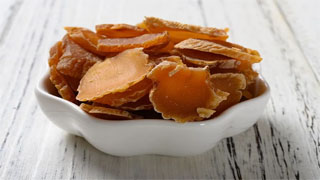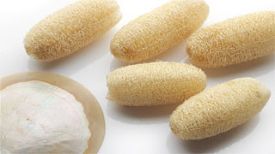
1. Aliases
Cooked ginseng.2. Plant morphology
Perennial herbaceous plant, reaching up to 60 centimeters in height. Mainly robust, fleshy, cylindrical or spindle shaped, with a pale yellow outer skin, often forked at the lower end, and rhizomes at the top. The stem is single and upright. Palm shaped compound leaves rotate at the stem end, usually one year old (referring to the second year of sowing) has one compound leaf composed of three leaflets, and two years old also have one compound leaf composed of five leaflets. Three years old have two compound leaves, four years old have three compound leaves, and five years or more have 4-6 compound leaves. The petiole is 6-13 centimeters long, and the central leaflet is the largest, elliptical to elongated, 8-12 centimeters long and 3-5 centimeters wide. The tip is gradually pointed, and the base is wedge-shaped and extends downwards. The edge has fine serrations, and there are sparse bristles on the upper veins. The umbrella shaped inflorescence is terminal, and the total flower stalk is pulled out from the center of the stem and petiole, with more than 4-40 small flowers. Drupe berry shaped, flattened spherical, bright red when ripe, containing 2 seeds. The flowering period is from June to July, and the fruiting period is from July to September.
3. Origin distribution
Produced in Heilongjiang, Jilin, and Liaoning. Take Fusong, Ji'an, Changbai, Jingyu in Jilin, Huanren in Liaoning, Kuandian, Xinbin, Qingyuan in Kuandian, and Yilan and Ning in Heilongjiang as authentic places.
4. Harvesting and processing
Harvest in autumn, wash, steam and dry.
5. Characteristics of medicinal herbs
The main root is spindle shaped, cylindrical or flattened, with a length of 3-10 centimeters and a diameter of 1-2 centimeters. The surface is semi transparent, reddish brown, with occasional opaque dark yellow brown patches. It has longitudinal grooves, wrinkles, and twisted and intersecting branches of fine roots, with curved fibrous roots or only residual fibrous roots. The length of the rhizome (reed head) is 1-2 centimeters, with several concave shaped stem marks (reed bowl) on it, some with 1-2 intact or broken adventitious roots (steps). Hard and brittle in texture, with a flat cross-section and a keratin like appearance. The gas is slightly fragrant and unique, with a sweet and slightly bitter taste.
6. Nature, taste, and meridian tropism
Warm in nature, sweet and slightly bitter in taste. Guipi Meridian, Lung Meridian, Heart Meridian, and Kidney Meridian.
7. Effect and function
Greatly tonifying vital energy, restoring meridians and strengthening detachment, tonifying qi and absorbing blood. It belongs to the category of tonifying qi medicines under the category of tonifying deficiency medicines.
8. Clinical applications
Dosage of 3-9 grams, decoct and mix separately. It is commonly used for body deficiency and the desire to detach, with cold limbs and slight pulse. Qi does not absorb blood, resulting in collapse and leakage of blood.
9. Pharmacological research
Red ginseng can regulate the nervous, cardiovascular, and endocrine systems, promote substance metabolism in the body, and synthesize proteins, RNA, and DNA. It has an excitatory effect on the central nervous system, but in large quantities, it actually has an inhibitory effect. It can enhance the excitation and inhibition process of advanced neural activity in animals. And it can enhance the body's ability to adapt to all non-specific stimuli, reduce fatigue (the roots, stems, and leaves of red ginseng can all prolong the duration of swimming in mice).
10. Chemical composition
The chemical components of red ginseng are mainly saponins and volatile oils, as well as fatty acids, amino acids, sterols, flavonoids, etc
11. Taboos for use
Not suitable for use with quinoa and wulingzhi. Patients with heart disease and hypertension should take it under the guidance of a physician before taking it. Red ginseng is also not suitable for teenagers during their growth and development period, as it can lead to early puberty.
12. Compatibility prescription
Weakness, yang disease, tinnitus, eye blossom and other symptoms: 80g of wolfberry fruit, 60g of cooked rehmannia root, 15g of red ginseng, 50g of polygonum multiflorum, 20g of poria cocos, and 1000ml of Baijiu. Grind the first five flavors into coarse powder, put them into a cloth bag, put them into a container, add Baijiu, seal them, shake them every other day, soak them for 14 days, and then use them. Add as much wine as possible, and the taste will stop when it is thin. Oral administration. Take 20 milliliters each time, twice a day. (Clinical Formula Collection)
The content of the article is for clinical reference only. Non professionals in traditional Chinese medicine are not allowed to try medication.


